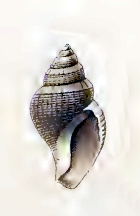Biology:Oenopota schantaricum
| Oenopota schantaricum | |
|---|---|

| |
| Image of a shell of Oenopota schantaricum | |
| Scientific classification | |
| Domain: | Eukaryota |
| Kingdom: | Animalia |
| Phylum: | Mollusca |
| Class: | Gastropoda |
| Subclass: | Caenogastropoda |
| Order: | Neogastropoda |
| Superfamily: | Conoidea |
| Family: | Mangeliidae |
| Genus: | Oenopota |
| Species: | O. schantaricum
|
| Binomial name | |
| Oenopota schantaricum (Middendorf, 1849)
| |
| Synonyms[1] | |
| |
Oenopota schantaricum is a species of sea snail, a marine gastropod mollusk in the family Mangeliidae.[1]
Description
The length of the shell varies between 20 mm and 30 mm. The shell has an ovo-fusiform shape. The whorls are tumid, occasionally faintly angulated, occasionally rounded (most frequently the body whorl). The aperture is longer than the spire and not much dilated. The siphonal canal is short and wide. The sculpture consists of fine, close, undulated spiral striae and axial folds, which, in adult specimens, often, almost disappear on the ultimate whorl, whilst they, invariably, are recognised on the upper whorls.
The teeth in the radula are ensiform with a short manubrium.[2]
Distribution
This marine species occurs off Japan and in the Okhotsk Sea
References
- ↑ 1.0 1.1 Oenopota schantaricum (Middendorf, 1849). Retrieved through: World Register of Marine Species on 11 August 2011.
- ↑ Friele H., 1877: Preliminary report on the Mollusca from the Norwegian North Atlantic Expedition in 1876; Nyt Magazin for Naturvidenskaberne 23: 1–10, 1 pl.
 This article incorporates text from this source, which is in the public domain.
This article incorporates text from this source, which is in the public domain.
- Middendorf, Aleksandr Fedorovich. Beiträge zu einer Malacozoologia rossica. Gedruckt bei der Kaiserlichen akademie der wissenschaften, 1849.
External links
- Tucker, J.K. 2004 Catalog of recent and fossil turrids (Mollusca: Gastropoda). Zootaxa 682:1–1295.
- "Obesotoma schantarica" (in en). Gastropods.com. http://www.gastropods.com/7/Shell_8857.shtml.
Wikidata ☰ Q7078641 entry
 |

